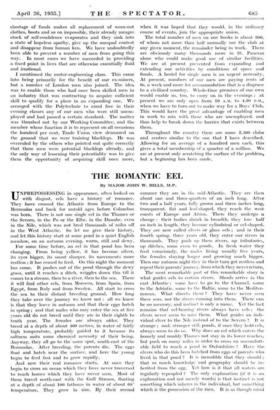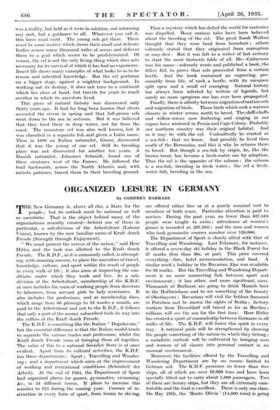THE ROMANTIC EEL
By MAJOR JOHN W. HILLS, M.P.
UNPREPOSSESSING in appearance, often looked on with disgust, eels have a history of romance. They have crossed the Atlantic from Europe to the Bermudas and back for untold ages before Columbus was born. There is not one single eel in the Thames or the Severn, in the Po or the Elbe, in the Danube, even in the Nile; which was not bred thousands of miles off in the West Atlantic. So let me give their history, andlet.this history, start at some pond in a quiet English meadow, on an autumn evening, warm, still and dewy.
For some, time before, an eel in that pond has been changing. From being yellow, it has become, silver, its eyes bigger, its .snout sharper, its movements more restless ; it has ceased to. feed. On this night the moment has come. It pushes. out of the pond through the dewy grass, until it, reaches, a ditch, wriggles down this till it comes to a stream, then to a river, then to the sea. There it will find other eels, from Morocco,. from. Spain, from Egypt, from Italy and from Sweden. All start . to cross the sea. to their distant breeding ground. How long they take over the journey we, know not : all we know is that they. leave in autumn and that their eggs hatch in spring ; and that males who may enter the sea, at five years. old do not breed until they are in their eighth to tenth year. The females are . always older. They breed at a depth of about 400 metres, in water of fairly high temperature,. probably guided to it because its saltness „suits some chemical necessity of their being. Anyway, they all go to the same spot, south7east of the Bermudas. After breeding, the parents die. The eggs float and hatch..near the surface, and here the young begin. to feed fast and to grow rapidly.
And now their real romance starts.. At once they begin to cross an ocean which they have never traversed to reach homes which they have. never seen. Most of them travel. north-east with the Gulf Stream, floating at a depth of about 100. fathoms in water of about 68° temperature. They grow size. By , their second summer they are in the mid-Atlantic. They are then about one and three-quarters of an inch long. After two and a half years, fully grown and three inches long, transparent, flat. and leaf-shaped, they reach the west coasts of Europe and Africa. There they undergo a change :, their bodies shrink in breadth, they lose half an inch in length, they become cylindrical or eel-shaped. They._ are now called elvers or glass eels ; and in their fourth spring, three years old, they enter our rivers in thousands. They push up these rivers, up tributaries, up ditches, _ some even to ponds. In fresh water they feed voraciously, the males living usually five years, the females staying longer and growing much bigger. Then one autumn night they in their turn get restless and repeat their parents' journey, from which they never return, The most remarkable part of this remarkable story is what guides eels to certain rivers. Shoals arrive in the east Atlantic : some have to, go to the Channel, some to the Adriatic, some to the Baltic, some to the Mediter- ranean. What directs them ? They have never seen these seas, nor the rivers running into them. There can be no memory, and instinct is only a name. Yet the fact remains that eel-bearing rivers always have eels ; the elvers never seem to miss them. What guides an indi- vidual elver to the Nile instead of to the Severn ? It is strange ;, and, stranger still, ponds, if once they hold eels, always seem to do so. Why does an eel which enters the homely and muddy Thames not stay in its lower reaches, but push on many miles in order to cross an uncomfort- able field to reach a pond in Oxfordshire ? Have the dyers who do this been hatched from eggs of parents who lived in that pond ? It is incredible that they should ; that so much knowledge and geography should be in- herited from the egg. Yet how is it that all waters are regularly repeopled ? The only explanation (if it is an explanation and not merely words) is that instinct is not something which inheres in the individual, but something which is the possession of the race, It is as though mind was a reality, but held as it were in solution, not informing any unit, but a guidance to all. Whatever you call it, this force must exist. The young eels get there. There must be some motive which steers their small and delicate bodies across many thousand miles of ocean and delivers them to a goal which seems to be predetermined. Of - course, the eel is not the only living thing which does acts necessary for its survival of which it has had no experience. Insect life shows many examples of what looks to us to be reason and inherited knowledge. • But the eel performs on a bigger stage, against a mightier background. In working out its destiny, it does-not turn to a continent which lies close at hand, but travels for years to reach another in which its ancestors lived. • This piece of natural history was discovered only thirty years ago. It had for long been known that elvers ascended the rivers in spring and that full-grown eels - went down to the sea in autumn. But it was believed that they bred there in deep water, not far from the coast. The immature eel was also well known, but it was classified as a separate fish and given a Latin name. Then in 1896 an Italian naturalist, Grassi, discovered- that it was the young of our eel. Still its breeding- place was not discovered for another ten years. A' Danish naturalist, Johannes Schmidt, found one of these creatures west of the Fames. He followed the trail backwards, across the North Atlantic and, with infinite patience, traced them to their breeding ground. Thus a mystery which has defied the world for centuries was dispelled. Many curious tales have been believed about the breeding of the eel: • The great Izaak Walton. thought that they were bred from horsehair ; others solemnly stated that they originated from corruption or may-dew. But it was left to a writer of last century to start the most fantastic fable of all. He—Cairncross was his name—solemnly wrote -and published a book, the Silver Eel, to prove that eels proceeded from a certain beetle. And the book contained an engraving, pre- sumably from life, of such a beetle, with its carapace split open and a small eel emerging. Natural history has always been infested by writers of legends, but surely no more egregious one has ever been propagated.
Finally, there is affinity between migration of mature eels and migration of birds. Those birds which seek a warmer climate in winter return north to breed. The chiff-chaffs and willow-wrens now fluttering and singing in our copses have wintered in Persia and Cape Colony. Probably our northern country was their original habitat. And so it may be with the eel. Undoubtedly he started as a sea-fish :- that we know. And possibly he lived then south of the Bermudas, and this is why he returns there to breed. But though a sea-fish by origin, he, like the brown trout, has become a fresh-water one by adoption. Thus the eel is the opposite of the salmon : -the salmon is a sea-fish, breeding in fresh water ; the eel a fresh- water fish, breeding in the sea.











































 Previous page
Previous page